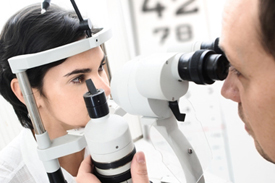
KERATOCONUS DIAGNOSIS
It can be difficult to diagnose keratoconus – especially in the early stages – because the symptoms associated with keratoconus could also be associated with other eye problems. Only specific tests may uncover this condition.

Keratoconus can usually be diagnosed with a corneal topography, an ophthalmoscope, a retinoscope or a slit-lamp examination.
The corneal topography exam is the most sensitive method for detecting early signs of keratoconus. It is a method by which a computer is used to analyze a series of rings of light projected onto the surface of the eye to make a detailed map of the surface of the cornea. These rings appear warped with the presence of keratoconus. Other signs of keratoconus that the doctor will see when examining your eyes include:
- Progressive corneal thinning
- Fleischer's ring (an iron colored ring surrounding the cone)
- Vogt's striae (stress lines caused by corneal thinning)
- Apical scarring (scarring at the apex of the cone)
Keratoconus requires a diagnosis from an eye doctor who is trained in recognizing the symptoms. The doctor will observe signs of keratoconus through direct measurement as well as examination of the cornea at a microscopic level using a slit lamp.


